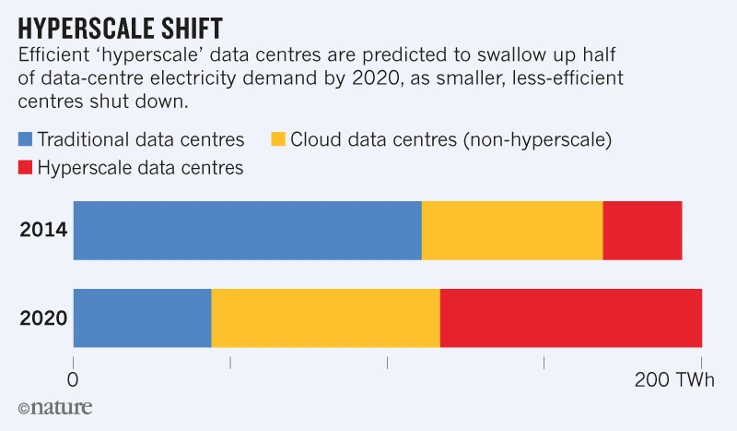Post-Pandemic Data Center Planning: What’s Next?17 min read

Let’s start with the obvious: we’re not entirely out of the COVID woods just yet. But there’s a light at the end of the tunnel, and folks in the data center and cloud industry are exceedingly interested in what happens next.
Setting our sights a few months, or even a year into the future, how are data centers changing? Are we back to the same old grind, or are there new goals and initiatives in the data center industry?
First, let’s cover some pretty clear numbers. A recent report from ReportLinker indicates that the global data center market size has witnessed a significant boost since the outbreak of the COVID-19 pandemic across the globe. The demand for data centers has increased because of the increased access to internet-related services aided by nationwide lockdowns imposed by governments worldwide. The COVID-19 pandemic has dramatically increased internet traffic between 25% and 30% during the initial lockdown period (March-April) worldwide, which is 10X times than average growth (~3% per month). Cloud-based services have observed a spike as organizations, including government bodies, require transferring, storing, and securing confidential data and information.
2021 and beyond will be hitting the accelerator as it relates to digital solutions.
“COVID-19 will take the wind from the sails of the data center network market during the middle part of 2020, but long-term growth prospects remain relatively bright, driven by continued demand from hyperscalers and other cloud customers and by enterprises modernizing and extending their datacenter networks for hybrid IT and multi-cloud. IDC expects multi-cloud networking to benefit as enterprises, reeling from COVID-19, adopt infrastructure that enables viable business resiliency and continuity.” — Brad Casemore, research vice president, IDC’s Datacenter Networks
Another report from Fortune Business Insights tells us that companies’ expanding utilization of data centers amid the COVID-19 pandemic further fueled this market’s growth. Furthermore, the rapidly evolving competitiveness in the global market and advanced technologies such as cloud computing and Big Data have made it simpler and cheaper for enterprises to shift their workload to self-contained data centers.
We’re going to focus on that last bit for a second.
Repatriating the Cloud
I’ve seen some exciting trends and numbers regarding cloud computing, hyperscalers, traditional enterprise data centers, and the cost equation in deploying the right workload in the right space.
So, is the data center about to kill the cloud? I bet some of you had to read that twice. The short answer is no. However, trends, statistics, and non-anecdotal research are indicated a certain level of maturity in the cloud and data center market. For two years in a row, most respondents to the AFCOM State of the Data Center Report have indicated that they are seeing cloud repatriation happening.
We even discussed the topic here a few months ago.
The tremendous savings seen from the switch to up-front CapEx investments in information technology to subscription mode soon gets soured as the rising monthly bills come in for services nobody knows where and when used. And so, new technology and operational disciplines were born: FinOps. In this professional, people leverage tools and new methodologies to monitor, measure, and mitigate the costs and value delivered from the cloud. FinOps practitioners’ perspectives (yes, they are out there) provide a good understanding of what lies ahead in the cloud:
“The dirty little secret of cloud spend is that the bill never really goes down,” says J.R. Storment, executive director of the FinOps Foundation.
In a recent article from Nature, we learned that in a 2016 report, the Lawrence Berkeley National Laboratory estimated that if 80% of servers in small US data centers were moved over to hyperscale facilities, this would result in a 25% drop in energy use. If you take a look at the data center and hyperscale market today, you’d see that this is very much already underway.
Today, the world has around 600 hyperscale data centers, many of them mopping up services for small corporations or universities that would have had their servers in the past. And, there are around 6,600+ colocation and wholesale data center facilities across North America, EMEA, Asia-Pacific, and Latin America.
Speaking in terms of dollars, a recent post from a16z gives us a real-world example around cloud cost and repatriation. They talk about a large-scale repatriation project by a pretty sizable organization. You may have heard of them: Dropbox. According to the post, when the company embarked on its infrastructure optimization initiative in 2016, it saved nearly $75M over two years by shifting the majority of its workloads from public cloud to “lower cost, custom-built infrastructure in colocation facilities” directly leased and operated by Dropbox.
The results: Dropbox’s gross margins increased from 33% to 67% from 2015 to 2017.

If you’re a fan of cloud, please don’t start sending me ‘fan mail’ telling me I’m going crazy. It’s evident that cloud computing isn’t going anywhere. And having spent some time designing cloud workloads, helping organizations refactor apps into the cloud, and helping build multi-cloud architecture, I can tell you that cloud computing has a firm footing in our digital world. So, what’s changed?
Our understanding of cloud workloads, where specific resources should live, and how we can plan for the future are all considerations when we think about what needs to be deployed where. The fun part is that we see a better balance between the cloud and the data center.
Another critical point is what’s happening to smaller, traditional, and even enterprise data centers. They’re going away… quickly. Honestly, I think this is great. We’re removing infrastructure that was there to fulfill a computing purpose and not much else. They’re often not efficient and prone to issues like outages and downtime. I’m excited that leaders in the business world see this colocation and ‘hyperscale shift’ where they see the direct benefits of moving from less efficient infrastructure to highly resilient and efficient hyperscale and colocation solutions.
For post-pandemic planning, this is a trend to embrace. Data center leaders need to be reaching out to enterprise leaders and helping them build their business, while you, the hyperscale and colocation expert, help them design their digital infrastructure.
Post-Pandemic: What’s Next?
This is really a chance for many leaders in the digital infrastructure space to embrace new solutions and new approaches to the market. Some are looking into robotics and automation, while others are investing even more into security. Similarly, with the growth around edge computing, leaders are also looking into more effective ways to manage critical infrastructure pieces remotely.
The big point here is that data centers are a vital part of our connected society. Post-pandemic planning must include deeper conversations around cloud utilization and balance, infrastructure efficiency, and how you’ll be supporting a far more distributed workforce.
Real-time monitoring, data-driven optimization.
Immersive software, innovative sensors and expert thermal services to monitor,
manage, and maximize the power and cooling infrastructure for critical
data center environments.
Real-time monitoring, data-driven optimization.
Immersive software, innovative sensors and expert thermal services to monitor, manage, and maximize the power and cooling infrastructure for critical data center environments.

Bill Kleyman
Industry Analyst | Board Advisory Member | Writer/Blogger/Speaker | Contributing Editor | Executive | Millennial
Bill Kleyman is an award-winning data center, cloud, and digital infrastructure leader. He was ranked globally by an Onalytica Study as one of the leading executives in cloud computing and data security. He has spent more than 15 years specializing in the cybersecurity, virtualization, cloud, and data center industry. As an award-winning technologist, his most recent efforts with the Infrastructure Masons were recognized when he received the 2020 IM100 Award and the 2021 iMasons Education Champion Award for his work with numerous HBCUs and for helping diversify the digital infrastructure talent pool.
As an industry analyst, speaker, and author, Bill helps the digital infrastructure teams develop new ways to impact data center design, cloud architecture, security models (both physical and software), and how to work with new and emerging technologies.
0 Comments